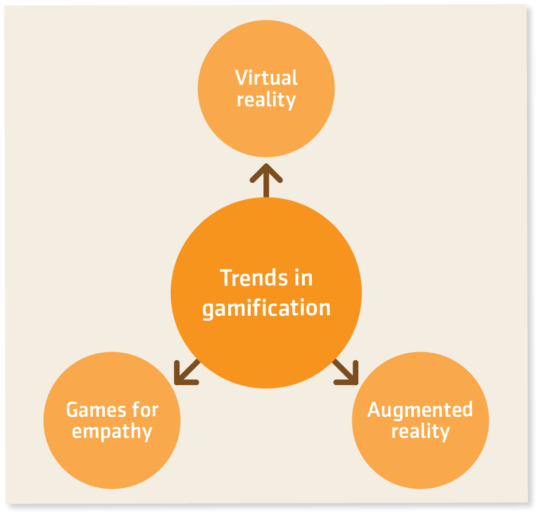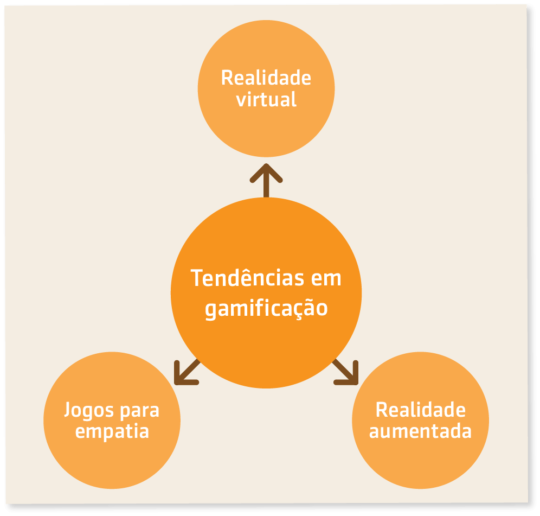Hi, I am here with Karl Kapp a great expert in gamification and learning and we will talk about trends in gamification. I am Wagner Cassimiro and this is the Espresso3.
Hi Karl! What are the main trends in gamification?
That is a great question. I see three big trends in using games and gamification for learning. The first is virtual reality. I think virtual reality is starting to really take hold. I see a lot of people developing learning games in virtual reality and using virtual reality as a method of designing a learning game.
Second, and I think it will become bigger than virtual reality, is augmented reality. So using a game layer on top of a normal business processes, for example, having people search things out and get points if they are working for an organization where they got to find inventory, or materials, or thing like that. I see augmented reality really becoming the next step of learning games and gamification, because you can add a points’ layers and a game layer on top of everything, and that can be very motivating and exciting from that perspective.
And the third thing I see that is happening is the use of games for empathy. So, there is this big movement call “games for change”, and a movement called “pro social gaming”. Pro social gaming is using game elements to faster pro social or friendly or a kind of behavior. For example, I can see someone in the floor who selling things playing a little game that really is pro social and gets them interacting and friendly with the client or customer. A customer walks in, and because they’ve played that game and they are interested in it, they are now more predisposed to be nice and pro social to the customer. So those are the three trends that I am seeing.
What are the challenges that companies, educators, and learners would have to have success on it?
One of the challenges I think that organizations have when they go into gamification is they bite off too big of a piece of it. They try to gamify everything, or they try to gamify a large process. So usually, what I say to start with: start a very small gamification implementation and then move out from there.
Second is: Work with an organization that has done gamification before, and that understands gamification as a vendor, a consultant, or somebody that has a sense of what gamification is and how it works.
The third thing, and maybe this should be the first thing, is to go back to what the business need driving gamification? I see a lot of organizations go: “Oh! Gamification is great! Millennials need gamification, let’s do gamification” not really understanding that they need to drive a business result from the gamification, or understanding it, but not being as aware as they should be. So I think that those are the three mistakes that are often made when implementing gamification.
Thank so much!
TRADUÇÃO
Oi, estou aqui com o Karl Kapp, um grande especialista em gamificação e aprendizagem, e falaremos sobre as tendências da gamificação. Eu sou Wagner Cassimiro e este é o Espresso3.
Oi Karl! Quais são as principais tendências da gamificação?
Essa é uma ótima questão. Vejo três grandes tendências no uso de jogos e gamificação na aprendizagem. A primeira é a realidade virtual. Eu acho que a realidade virtual está realmente decolando. Eu vejo muitas pessoas desenvolvendo jogos de aprendizagem com realidade virtual e usando a realidade virtual como um método na concepção de um jogo de aprendizagem.
Em segundo lugar, e acho que esse vai se tornar maior do que a realidade virtual, é a realidade aumentada que é usar uma camada de jogo em cima de um processo de negócios normal. Por exemplo, fazer com que as pessoas busquem coisas e obtenham pontos se eles estão trabalhando para uma organização onde eles têm que encontrar materiais de inventário, ou algo assim. Eu vejo que a realidade aumentada irá se tornar o próximo passo na aprendizagem de jogos e gamificação, porque você pode adicionar camadas de pontos e uma camada de jogo em cima de tudo, e isso pode ser uma perspectiva muito motivadora e divertida.
E a terceira coisa que vejo que está acontecendo é o uso de jogos para empatia. Então, há esse grande movimento chamado “jogos para mudança”, e um movimento chamado “jogo pró-social”. O jogo pró-social usa elementos de jogo para melhorar uma interação social ou amigável ou para melhorar um tipo de comportamento. Por exemplo, eu posso ter algum vendedor jogando um pequeno jogo que é pró-social e o faz interagir e ser amigável com o cliente. Quando um cliente entra na loja, por terem jogado esse jogo e eles estarão mais interessados e mais predispostos a serem gentis e sociáveis com o cliente. Essas são as três tendências que eu vejo.
Quais são os desafios que as empresas, educadores e aprendizes terão para ter sucesso nisso?
Um dos desafios é que eu acho que quando as organizações começam a fazer gamificação elas tentam abocanhar mais do que podem. Elas tentam gamificar tudo ou tentam gamificar um grande processo. Então, geralmente, o que eu digo para começar é: comece com uma implementação de gamificação pequena e depois vá crescendo.
O segundo ponto é: Trabalhar com uma organização que já fez gamificação antes, e que entende de gamificação, como um fornecedor, um consultor ou alguém que tenha uma noção do que é gamificação e como ela funciona.
A terceira coisa, e talvez essa devesse ser o primeiro ponto, é pensar para que a empresa precisa fazer a gamificação? Eu vejo muitas organizações falarem: “Oh! Gamificação é ótimo! Millennials precisam de gamificação, vamos fazer gamificação!” e não entendem que eles precisam gerar um resultado de negócios da gamificação. Ou até entendem, mas não estão tão conscientes como deveriam estar. Eu acho que esses são os três erros que muitas vezes são feitos na implementação de gamificação.
Muito obrigado!


